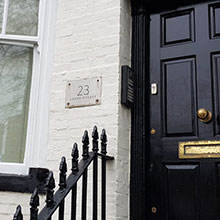
More Marketing Tips for Small Businesses
Part 3: Branding and PR
For the third part in our series on bolstering your marketing as a small business, we’re going to take a look at why establishing a strong and consistent brand identity is fundamental to building customer loyalty and standing out in a crowded marketplace. Then we’ll explore how this ties in with utilising effective PR to not only build your brand but to support your other marketing efforts, both online and offline.
Integrating effective branding with the importance of PR can significantly enhance a company’s public relations efforts, fostering the trust and credibility that underpin long-term business success. Our aim with this post is to complement our previous posts: Online Marketing for Small Businesses: SEO & Social Media, and Mastering Email Marketing & PPC, to provide small business owners with actionable insights and marketing tips to develop a robust brand presence, ultimately driving sales and ensuring growth.
Crafting a Memorable Visual Identity
Importance of Brand Consistency
A cornerstone of effective branding strategies for businesses of all sizes, ensuring that every touchpoint reflects a consistent brand identity is crucial. Put simply, this means using the same logos, colour palettes, typography and tone of voice across all marketing channels, from social media platforms to your website, from email newsletters to ad copy. A consistent brand identity not only builds recognition as you grow your brand but also fosters trust and reliability among existing customers along with prospective customers.
A good designer can help you to build a brand kit or set of brand guidelines that will include specifics on precise colours to be used in different scenarios and exactly how far from the margins different elements of your logo should be. It may sound trivial but by having set rules for every minutiae of brand appearance, you set yourself high standards by which to maintain consistency for the future.
Consistent branding helps reinforce the brand message, making it more likely that customers remember your business during their purchasing decisions. In a world where online visibility is key, having a unified brand across different digital marketing channels can help your brand stand out when it shows up in different places. From the logo and language used in your search engine listings to the colours and themes consistent in your posts on the social platforms you frequent, by staying on brand you’ll stay memorable.

Effective Storytelling Techniques
Storytelling is a powerful tool in crafting a memorable visual identity. For small businesses, effective storytelling can humanise a brand, making it relatable and engaging. You should be able to define your brand’s core message and values, in simple, understandable terms. Don’t go for vague concepts and instead opt for focusing on who you’re for, what you’re about and why you’re better than competitors.
Once you’ve determined this narrative it should permeate all marketing efforts, from social media posts to customer interactions on mobile devices. Use real-life stories, such as customer testimonials or behind-the-scenes content, to create those valuable emotional connections. Visual elements, such as compelling unique images and videos (you should be avoiding stock imagery), can enhance your storytelling by making it more vivid and memorable. Incorporating user-generated content can also be an excellent way to build brand authenticity and trust. Where you offer goods or services online, encouraging reviews will give you more content you can later utilise in your messaging.
Additionally, ensuring the story is consistent across all of your marketing channels strengthens your brand’s presence and recognition. By weaving a cohesive and engaging narrative, small businesses can increase their appeal to both existing and potential customers, encouraging loyalty and repeat interactions.
Building Your Strong Brand Presence
It’s not enough to merely always use the same font for your business name. In modern marketing at the very least you’ll need a distinctive logo and harmonious colour palette that reflects your brand’s personality. Think about the different common places your logo might appear, can it be altered to suit different environments? For example where a longer logo may fit nicely across a letterhead or the top of your website, a more condensed version could be better suited for use in the corner of Instagram images (which are usually in portrait orientation).
Similarly you’ll want to be mindful of where your customers are engaging with you. Modern responsive websites that scale depending on the device on which they’re being viewed have become the norm, avoiding the messiness of hard to read text on a mobile screen that would be easier to see on a desktop, but from laptop to tablet to mobile, your logo needs to be scaleable too. This is where your brand guidelines once again come to the fore and you should have different versions of your logo applicable to multiple different use cases.
Your Design: Online & Offline
For a truly cohesive design strategy your brand’s visual identity should seamlessly translate from digital formats to physical materials. This means ensuring that the colours, fonts and imagery used in your online marketing efforts are mirrored in offline materials such as business cards, packaging, signage and other marketing collateral.
For online platforms, ensure your website and social media accounts reflect your brand’s visual identity, creating a unified experience for internet users. You can have different colours on different platforms, as long as they come from your previously agreed colour palette. Often brands will have various different colour-ways for their logo in order to make it easier to apply to different backgrounds, or just to keep things interesting! But the colours should always stay on brand. For instance having logo colour-ways that utilise bright, bold, primary colours can work really well for some brands but you wouldn’t want to then also use muted, pastel tones for the logo in other instances. Stick with the palette.
Offline, make sure your physical branding materials carry the same level of professionalism and design quality. Again, these should adhere to the brand guidelines you’ve already laid out. The advantage of having specified the precise colours to be used in your materials is that they should appear the same in print as they do on screen, thanks to the use of specifically named colours and hex codes instead of just specifying “dark blue background, light blue font” for example.

Leveraging Public Relations for Growth
Enhancing Trust with Customers
Trust is built through transparency and consistent communication so effective PR can help you to keep on top of your authority brand building. Small businesses can enhance trust by being open about their processes, values and corporate social responsibility and sustainability initiatives. Providing clear and honest information about products or services fosters credibility whilst engaging with customers through social media platforms allows businesses to address concerns and respond to feedback promptly, demonstrating commitment to customer satisfaction.
Public relations efforts should also include showcasing testimonials and case studies that highlight positive customer experiences. Additionally, participating in community events and collaborations with other businesses can strengthen local ties and enhance reputation. You might also want to consider partnerships with local sports groups and other organisations you have a connection with, showcasing your community credentials, helping worthy causes and getting your brand associated with groups and teams that share your values. Trust is not only a catalyst for customer loyalty but also a significant driver of word-of-mouth recommendations, so positive PR can more than pay for itself in the long run, whether engaging outside specialists, getting in-house PR support or taking the time to work at it yourself .
Digital PR and the Race for Links
Traditional PR is great for sharing your message, making announcements via press releases or earning a bit of local media attention, but digital PR is just as important in the modern marketing landscape, especially for small businesses seeking to improve their online visibility. At its core, digital PR involves creating engaging, valuable and unique content that attracts attention and ultimately earns valuable backlinks from reputable websites. If you’ve read our earlier post on SEO you’ll know that these links are crucial for enhancing search engine rankings and driving website traffic by building the authority of your website.
To succeed in the race for links, small businesses should focus on developing high-quality, shareable content that resonates with their target audience. This might include informative blog posts, eye-catching infographics or engaging videos, and you should conduct your own research enabling you to share data and insight not readily available already. Additionally, reaching out to industry influencers and bloggers for collaborations can help amplify your content’s reach and generate even more backlinks.
Monitoring digital trends (such as via Google Trends) and participating in relevant online conversations can also create opportunities for link building. Take a look at what’s generating discussion on platforms like Linkedin to identify opportunities to establish yourself or your business as a thought leader in the industry, contributing to greater trust in your brand.

Long-term Benefits of PR Strategies
Whilst digital ad campaigns can provide plenty of data to demonstrate their relative success and return on investment, PR campaigns can be harder to measure. It’s easy to track if someone has followed a link in an ad and then continued their journey to make a purchase or enquiry through your website. But the impact of PR across different disciplines isn’t always quite so tangible. They key is to look at it with a long term view, recognising that reputation building will take time and getting your brand in front of more eyes may not yield immediate improvements to your bottom line, but the more you’re bieng seen the more chances you have of being remembered for the right reasons.
As PR activities focus on maintaining a positive image and transparent communication, they foster customer loyalty, which is crucial for sustained business growth. Increased media coverage and improved brand recognition will make it easier to attract new customers, and staff, whilst over time, a robust PR strategy can establish a business as an industry authority, enhancing its credibility and competitive edge. This long-term approach not only supports immediate marketing goals but also lays the groundwork for future success, ensuring that your small business can remain relevant and resilient in a dynamically evolving market environment.
If you’ve got your brand working hard and find your business is growing rapidly as a result, it could be time to upgrade your working environment. Graduating from home office to a dedicated space is often the next logical step in a small business’ evolution so if you find you’ve outgrown where you began, or you just need somewhere to meet with your growing roster of staff and clients, why not get in touch with JetSpace about our serviced office space in Brighton and Shoreham!
Call on 01273 917977 or complete our enquiry form
enquire book a viewing

